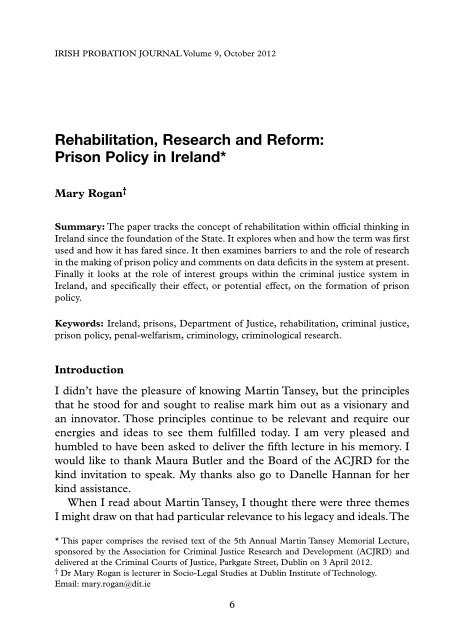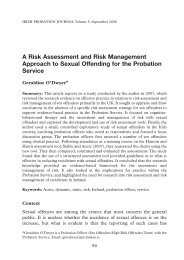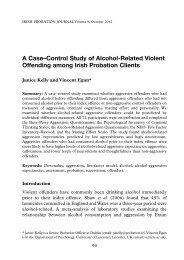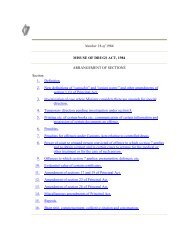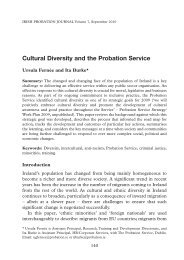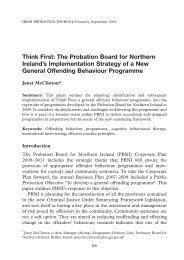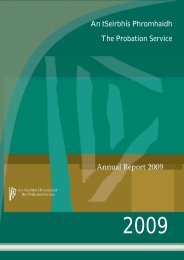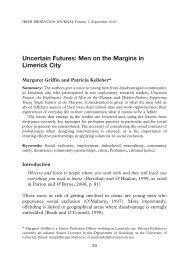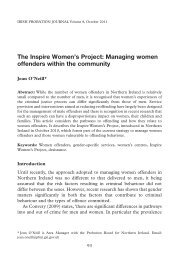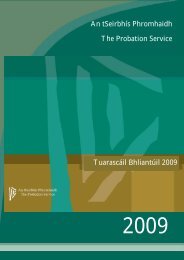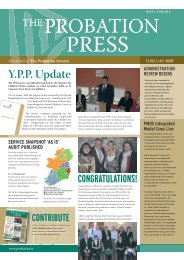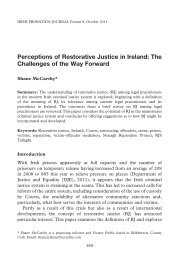Prison Policy in Ireland - The Probation Service
Prison Policy in Ireland - The Probation Service
Prison Policy in Ireland - The Probation Service
You also want an ePaper? Increase the reach of your titles
YUMPU automatically turns print PDFs into web optimized ePapers that Google loves.
01 Vol. 9 Body 2012_IPJ 03/10/2012 13:19 Page 7Rehabilitation, Research and Reform 7first was the concept of rehabilitation, the second the possible impact ofresearch on policy, and the third was the role and importance of ‘<strong>in</strong>terestgroups’ with<strong>in</strong> the crim<strong>in</strong>al justice system.I propose, therefore, to exam<strong>in</strong>e these three themes with<strong>in</strong> this paper.First, I would like to track the concept of rehabilitation with<strong>in</strong> officialth<strong>in</strong>k<strong>in</strong>g s<strong>in</strong>ce the foundation of the State. I will explore when and howthe term was first used and how it has fared s<strong>in</strong>ce. Secondly, I would liketo exam<strong>in</strong>e barriers to and the role of research <strong>in</strong> the mak<strong>in</strong>g of prisonpolicy and to say a few words about data deficits <strong>in</strong> our system at present.F<strong>in</strong>ally, I would like to look at the role of <strong>in</strong>terest groups with<strong>in</strong> thecrim<strong>in</strong>al justice system, and specifically their effect, or potential effect, onthe formation of prison policy.<strong>The</strong> concept of rehabilitationI had the pleasure of hear<strong>in</strong>g Professor Fergus McNeill give this lecture<strong>in</strong> 2009, and he delivered a masterful exam<strong>in</strong>ation of the concept ofrehabilitation that I would not be able to emulate, nor wish to rehash. Myfocus is on how this concept emerged, was fashioned and developed <strong>in</strong><strong>Ireland</strong>.As Fergus McNeill said <strong>in</strong> his lecture, rehabilitation is both a penalconcept and a penal practice (McNeill, 2009). <strong>The</strong> word is also used todescribe a process of be<strong>in</strong>g rehabilitated or an outcome. As McNeill madeclear, there are very many other vexed questions aris<strong>in</strong>g out of any attemptto describe what rehabilitation means. Some see it as a quasi-religiousnotion, others a form of re-education, others a k<strong>in</strong>d of medical treatment;some a paternalistic, coerced and enforced set of practices, otherssometh<strong>in</strong>g that is legitimate only when engaged <strong>in</strong> freely by an <strong>in</strong>dividualhimself or herself (see further the excellent analysis <strong>in</strong> Ward and Maruna,2006).In this paper, I am not <strong>in</strong>terested <strong>in</strong> what rehabilitation is, might be orshould be, so much as how the concept itself has developed <strong>in</strong> Irish penalth<strong>in</strong>k<strong>in</strong>g. My emphasis will be on how the term or, more specifically, theidea of rehabilitation was conceived of and used by policy-makers. <strong>The</strong>way <strong>in</strong> which the concept was translated <strong>in</strong>to practice is, of course, anentirely different matter. I want to explore how <strong>Ireland</strong>’s penal policymakersused the term and what they meant, or thought they meant, whentalk<strong>in</strong>g about rehabilitation.
01 Vol. 9 Body 2012_IPJ 03/10/2012 13:19 Page 88 Mary RoganUnderstand<strong>in</strong>g policy formationHow policy-makers use terms such as rehabilitation is reveal<strong>in</strong>g of theirsensibilities regard<strong>in</strong>g punishment, the objectives of punishment, and therelative importance or priority between compet<strong>in</strong>g objectives. It istherefore useful shorthand by which we can understand penal th<strong>in</strong>k<strong>in</strong>ggenerally. In <strong>Prison</strong> <strong>Policy</strong> <strong>in</strong> <strong>Ireland</strong> (Rogan, 2011b) I attempted to lookclosely at what policy-makers were do<strong>in</strong>g, or thought they were do<strong>in</strong>g, atvarious key po<strong>in</strong>ts <strong>in</strong> the history of our prison policy. I consider this to bean essential, and somewhat underused, way of understand<strong>in</strong>g penalchange.<strong>The</strong>re is a grow<strong>in</strong>g literature on try<strong>in</strong>g to understand the actions ofpolicy-makers and the policy process as a way of expla<strong>in</strong><strong>in</strong>g penal change(Jones and Newburn, 2007; Stolz, 2002; Sparks and Newburn, 2004;Ryan, 2003; Wall et al., 2001), but <strong>in</strong> this regard I wish to drawparticularly on the work of Loader and Sparks, who suggest that it isimportant for us to understand how policy actors themselves talk aboutand conceive of their actions and <strong>in</strong>tentions (Loader and Sparks 2004).Advocat<strong>in</strong>g a process they call ‘historical recovery’, Loader and Sparksstate that:<strong>The</strong> procedure we envisage would subject … events to more search<strong>in</strong>gforms of historical research and reflection, aim to explore their<strong>in</strong>terplay with extant political imperatives and programmes and seekto explore the ideas and mean<strong>in</strong>gs that actors mobilise to encode/decode events and ‘name’ the legitimate response. (Loader and Sparks,2004, p. 15)While this is of great explanatory potential, it is also quite good fun torevisit and exam<strong>in</strong>e historical and contemporary politics and see howpoliticians and civil servants use language.Rehabilitation as a concept <strong>in</strong> Irish penal th<strong>in</strong>k<strong>in</strong>g<strong>Ireland</strong> provides a particularly <strong>in</strong>terest<strong>in</strong>g place to study the concept ofrehabilitation and how it has been used by policy-makers. Our sharedpenal, legislative and adm<strong>in</strong>istrative history with the United K<strong>in</strong>gdommeant that, at Independence, we had many of the structures <strong>in</strong> place that
01 Vol. 9 Body 2012_IPJ 03/10/2012 13:19 Page 9Rehabilitation, Research and Reform 9are associated with the rehabilitative turn <strong>in</strong> penal history. <strong>The</strong> Preven -tion of Crime Act 1908, the Children Act 1908 and the <strong>Probation</strong> ofOffenders Act 1907 were all British <strong>in</strong>ventions. We also had a penal systemthat was, as Osborough states, ‘largely the product of English penologicalthought’ (Osborough, 1985, p. 181), with prisons, partic ularly Mountjoy,be<strong>in</strong>g exemplars of Victorian th<strong>in</strong>k<strong>in</strong>g on how to organise punishment.While we had these foundational structures <strong>in</strong> place, <strong>Ireland</strong> tooksometh<strong>in</strong>g of a different path to its nearest neighbour with regard to bothprison policy and rehabilitation after Independence. This makes <strong>Ireland</strong>a very <strong>in</strong>terest<strong>in</strong>g case <strong>in</strong> which to study the ‘conditions’ <strong>in</strong> whichrehabilitation can be propagated.Rehabilitation and penal-welfarismWhen talk<strong>in</strong>g about rehabilitation we are, of course, talk<strong>in</strong>g also about‘penal-welfarism’ as an approach to or period of penal policy, associatedwith the period from 1895 until the 1960s. ‘Penal-welfarism’, also knownas or considered to encompass correctionalism or penal modernism, as apenal idea has been subject to <strong>in</strong>novative and expert analysis by DavidGarland <strong>in</strong> a most detailed and reflective early work, Politics and Welfare,published <strong>in</strong> 1985 (Garland, 1985). As an aside, it is <strong>in</strong>terest<strong>in</strong>g to reflectupon why this book has received much less attention than his morefamous Culture of Control (Garland 2001), or <strong>in</strong>deed why it has spawnedmuch less penological scholarship and critique.When we talk about penal-welfarism, the wider concept <strong>in</strong> whichrehabilitation is embedded, we are talk<strong>in</strong>g about a period <strong>in</strong> penal policyand penal th<strong>in</strong>k<strong>in</strong>g that had certa<strong>in</strong> key or characteristic features. <strong>The</strong>se<strong>in</strong>clude particular penal practices such as attempts to divert people fromprison through the use of f<strong>in</strong>es and probation, and, generally, a far greaternumber of sanctions requir<strong>in</strong>g the <strong>in</strong>put of the social and psychologicalsciences <strong>in</strong>to the legal milieu. <strong>The</strong>re was also a dist<strong>in</strong>ct transferral ofresponsibility for deal<strong>in</strong>g with those who had committed crimes fromprivate charity to a state funded and adm<strong>in</strong>istered system.<strong>The</strong> prison took on a new role and position with<strong>in</strong> this alteredstructure, be<strong>in</strong>g ‘decentred’ with<strong>in</strong> the penal–welfare complex. Many ofthe new sanctions <strong>in</strong>troduced dur<strong>in</strong>g this period were conceived of asalternatives to imprisonment, while others functioned to remove certa<strong>in</strong>classes of offender from the prison sett<strong>in</strong>g entirely. <strong>The</strong> prison alsobecame a place, <strong>in</strong> the imag<strong>in</strong>ation at least, of transformation of<strong>in</strong>dividuals – a sett<strong>in</strong>g for treatment rather than simply punishment.
01 Vol. 9 Body 2012_IPJ 03/10/2012 13:19 Page 1212 Mary Rogancomb<strong>in</strong>ation of moral and physical tra<strong>in</strong><strong>in</strong>g. This th<strong>in</strong>k<strong>in</strong>g was gett<strong>in</strong>gclose to penal-welfarism.<strong>The</strong> Government of the day, however, implemented the <strong>Prison</strong> Rules1947, which were largely Victorian <strong>in</strong> their outlook. <strong>The</strong>se Rules, designedto govern every aspect of prison life, were essentially adm<strong>in</strong>istrative,with an obvious concern with hygiene, cleanl<strong>in</strong>ess and good order –little attention was devoted to the question of the ‘treat ment’ of prisoners<strong>in</strong> a rehabilitative sense. <strong>The</strong> language of rehabilitation was,however, beg<strong>in</strong>n<strong>in</strong>g to appear, with the Visit<strong>in</strong>g Committee of the prisonat Sligo commend<strong>in</strong>g the changes brought about <strong>in</strong> penal regimes <strong>in</strong> the1940s for their impact on the rehabilitation and reformation of theprisoner.<strong>The</strong>se were isolated pockets, however, and rehabilitation did notpenetrate official th<strong>in</strong>k<strong>in</strong>g for some time to come. <strong>The</strong>re were some signsof change <strong>in</strong> 1958 when the then M<strong>in</strong>ister for Justice, Oscar Traynor TD,argued that rehabilitation was not possible <strong>in</strong> <strong>Ireland</strong> at the time becausesentences were too short. However, <strong>in</strong> a couple of years rehabilitationwent from be<strong>in</strong>g someth<strong>in</strong>g that was unusual, a bit exotic, and rarelyspoken of, to a central idea beh<strong>in</strong>d penal th<strong>in</strong>k<strong>in</strong>g – someth<strong>in</strong>g to beproud of; someth<strong>in</strong>g to show off. This happened dur<strong>in</strong>g the crucial decadeof the 1960s.Rehabilitation becomes fashionable: <strong>Ireland</strong> <strong>in</strong> the 1960sRehabilitation became fashionable <strong>in</strong> <strong>Ireland</strong> <strong>in</strong> the 1960s. Temporaryrelease was <strong>in</strong>troduced <strong>in</strong> the Crim<strong>in</strong>al Justice Act of 1960. It was<strong>in</strong>troduced not to alleviate overcrowd<strong>in</strong>g, which was part of the reasonfor its <strong>in</strong>troduction <strong>in</strong> the UK (Newburn, 2003) and <strong>in</strong>deed to which useit was put <strong>in</strong> <strong>Ireland</strong> later, but rather as a humanitarian measure forprisoners who needed to be at home for whatever reason for a shortperiod, and as a mechanism to prepare people for release. Its <strong>in</strong>tro ductionwas an <strong>in</strong>dication of th<strong>in</strong>gs to come. In 1962, Charles Haughey becameM<strong>in</strong>ister for Justice. I have written elsewhere about the impact he had onthe Department of Justice, which was, <strong>in</strong> my view, significant and longlast<strong>in</strong>g(Rogan, 2011a). No doubt this was a young M<strong>in</strong>ister, <strong>in</strong> his firstportfolio, desir<strong>in</strong>g to impress and to be seen to be active and forwardth<strong>in</strong>k<strong>in</strong>g.Haughey used the term ‘rehabilitation’ repeatedly <strong>in</strong> his discussionsabout prison. This is illustrated by some examples of the type of languagehe used:
01 Vol. 9 Body 2012_IPJ 03/10/2012 13:19 Page 13Rehabilitation, Research and Reform 13<strong>Prison</strong> will always be a place of punishment, but it seems to me thatour prisons nowadays must to an <strong>in</strong>creas<strong>in</strong>g extent become places ofrehabilitation as well. In so far as rehabilitation may save a person fromthe misery and degradation associated with a life of crime, it is entirelyjustifiable on humanitarian grounds alone. In addition, however, it canbe regarded as someth<strong>in</strong>g which br<strong>in</strong>gs a positive benefit to thecommunity as a whole. It can mean the difference between a formerprisoner cont<strong>in</strong>u<strong>in</strong>g as a burden on the community or becom<strong>in</strong>g auseful member of society. (Dáil Debates, vol. 198, col. 126–7, 27November 1962)He had the follow<strong>in</strong>g to say about temporary release: ‘I am veryenthusiastic about the system – the idea that you would trust somebodyto go out <strong>in</strong>to the world, to enable them to readjust themselves, these arethe important th<strong>in</strong>gs’. He argued that its use was ‘enormously beneficial’as it showed to a person that ‘we trust him’ and it ‘proves that everybodyisn’t aga<strong>in</strong>st him’. Overall, he considered that it could have ‘reallysatisfactory results’ (‘Young Offenders <strong>in</strong> St. Patrick’s Institution’, AnRadharc Archive, Ref. No. 9, available <strong>in</strong> the Irish Film Archive).It was not, however, solely Charles Haughey that was experienc<strong>in</strong>gthese new impulses and feel<strong>in</strong>gs, or was rid<strong>in</strong>g these w<strong>in</strong>ds of change. <strong>The</strong>Department of Justice was also work<strong>in</strong>g on proposals that can bedescribed as hav<strong>in</strong>g a rehabilitative ethos. Haughey and Peter Berry,Secretary General of the Department of Justice, comb<strong>in</strong>ed their forces toestablish an Inter-Departmental Committee on Juvenile Del<strong>in</strong>quency, the<strong>Probation</strong> System, the Institutional Treatment of Offenders, and theirAfter-Care <strong>in</strong> 1962. Aga<strong>in</strong>, this language was revolutionary. Haugheyhimself remarked that the recommendations made by the Committee had‘<strong>in</strong> the ma<strong>in</strong>, as their aim the social rehabilitation of the offender’ (DáilDebates, vol. 198, col. 124, 27 November 1962).In the 1962 An Radharc documentary referred to above, Haugheydescribed his plans for St Patrick’s Institution. He <strong>in</strong>formed the<strong>in</strong>terviewer that ‘we have a great deal of plans and ideas <strong>in</strong> m<strong>in</strong>d’<strong>in</strong>clud<strong>in</strong>g the primary hope to obta<strong>in</strong> a new, more spacious, build<strong>in</strong>g, and‘the provision of an educational psychologist and a matron to provide afem<strong>in</strong>is<strong>in</strong>g <strong>in</strong>fluence on the boys’. As we know, St Patrick’s rema<strong>in</strong>s <strong>in</strong>operation on that same site today.<strong>The</strong> Inter-Departmental Committee established <strong>in</strong> the 1960s engaged<strong>in</strong> other activities that were characteristic of penal-welfarism research.
01 Vol. 9 Body 2012_IPJ 03/10/2012 13:19 Page 15Rehabilitation, Research and Reform 15same year, <strong>The</strong> Even<strong>in</strong>g Herald reported that ‘a w<strong>in</strong>d of change is blow<strong>in</strong>gdown our prison corridors’, ow<strong>in</strong>g to the <strong>in</strong>troduction of correctivetra<strong>in</strong><strong>in</strong>g, ‘work parole’ and changes <strong>in</strong> the work practices of prison officers(28 April 1967).One very significant example of <strong>in</strong>creas<strong>in</strong>g media <strong>in</strong>terest <strong>in</strong> penalaffairs came <strong>in</strong> the form of a television documentary made for TelefísÉireann as part of the Discovery series <strong>in</strong> 1965. This was sanctioned bythe M<strong>in</strong>ister for Justice, Brian Lenihan, who hoped that:Such a documentary, show<strong>in</strong>g the new methods of treatment<strong>in</strong>troduced under our penal reform programme, would lead to greaterpublic <strong>in</strong>terest and co-operation <strong>in</strong> the efforts of prison adm<strong>in</strong>istrationto secure the social rehabilitation of persons discharged from prison.(letter from Lenihan to Rugheimer, Controller of Programmes, TelefísÉireann, 29 January 1965, National Archives, Department of JusticeFiles 2002/2/94)<strong>The</strong> programme apparently had ‘the M<strong>in</strong>ister’s enthusiastic approval’ andit was even hoped to show it at the forthcom<strong>in</strong>g UN Congress on CrimePrevention and Treatment of Offenders <strong>in</strong> Stockholm.<strong>The</strong> discourse of the documentary was characteristic of the period.<strong>The</strong> voice-over attested that ‘one of the constant factors <strong>in</strong> crime is lackof education’, also cit<strong>in</strong>g alcohol. A Welfare Officer was filmed say<strong>in</strong>g:‘now don’t forget – my job as Welfare Officer is to help you and yourfamily’. 1 <strong>The</strong> Governor was also shown guid<strong>in</strong>g prisoners <strong>in</strong>to what wasdescribed as ‘useful therapy’. An <strong>in</strong>terview with a warder elicited thisresponse: ‘the old style warder was … “custodian”. Today’s warder needsto be half psychologist, half schoolmaster and as much the prisoner’sfriend as his guardian.’<strong>The</strong> documentary concluded that with a prisoner ‘there is no po<strong>in</strong>tbe<strong>in</strong>g tough … the greatest truth of the prison service is that toughprisons are always full. Let us have prisons that can one day lie empty.’Such was the perception of change with<strong>in</strong> the system that the1 <strong>The</strong> prisoners’ cells <strong>in</strong> the ‘special land<strong>in</strong>g’ were also shown and it was stated the cells couldbe decorated as prisoners wished with pictures etc. Accord<strong>in</strong>g to an officer, Pope John XXIIIand President Kennedy were the most popular adornments, though the ‘old lags’ rarelydecorated their cells at all.
01 Vol. 9 Body 2012_IPJ 03/10/2012 13:19 Page 1616 Mary Rogandocumentary asked ‘have we simply gone soft on men?’, to which theGovernor replied ‘we are not here to punish men … our <strong>in</strong>tention is forthem to leave here as better citizens’.<strong>The</strong> Department of Justice was particularly receptive and enthused bythis project, reflect<strong>in</strong>g an openness towards penal matters that dissipated<strong>in</strong> the follow<strong>in</strong>g decade. Some of this openness must also be attributedto the filmmakers’ very favourable portrayal of the Irish system and theapproach of the prison authorities. <strong>The</strong> Producer of Discovery wrote <strong>in</strong> theRTÉ Guide that <strong>Ireland</strong> had ‘the most enlightened penal system <strong>in</strong> theworld’ and that, hav<strong>in</strong>g been <strong>in</strong> many prisons before, ‘I have neverencountered such a reformatory atmosphere as I did <strong>in</strong> Mountjoy’ (Letterfrom Kennerley to McCarthy, 3 May 1965, National Archives,Department of Justice Files 2002/2/94).<strong>The</strong> fact that this k<strong>in</strong>d of language and assessment was approved bythe Department is itself strik<strong>in</strong>g. Dur<strong>in</strong>g this period Justice officials weremore than comfortable with the notions of rehabilitation, assistance,tra<strong>in</strong><strong>in</strong>g and humane conditions. At no stage was there a discussion onthe possibility of a public outcry about such a portrayal of the prisonsystem, or concerns that perhaps voters or politicians would not bear theevidence of the documentary. <strong>The</strong> Department, <strong>in</strong> contrast, wanted to putforward such a position through the media, suggest<strong>in</strong>g that it was, at thistime at least, most enthusiastic about the ideas of modernisation of theprison system and prisoner welfare.Rehabilitation appears <strong>in</strong> legislationUltimately, the ongo<strong>in</strong>g commitment with<strong>in</strong> the Department of Justice tothis changed language led to changes <strong>in</strong> legislation under another youngM<strong>in</strong>ister, Dessie O’Malley, who became M<strong>in</strong>ister for Justice <strong>in</strong> 1970 atthe age of 31.O’Malley piloted the <strong>Prison</strong>s Act 1970 through the Dáil, though it wasessentially a civil service-driven development <strong>in</strong> gestation for several years.<strong>The</strong> <strong>Prison</strong>s Act 1970 was the legislative zenith of this period <strong>in</strong> Irishprison policy. Its immediate impetus was to provide statutory regulationfor Shanganagh Castle, which had been opened <strong>in</strong> 1968 as a semi-openprison for young people. However, the Act went further. Its preamble andexplanatory memoranda stated that its purpose was ‘to enable theM<strong>in</strong>ister for Justice, for the purpose of promot<strong>in</strong>g the rehabilitation ofoffenders, to provide places other than prisons for the detention ofpersons’. Rehabilitation was now an official aim of the Irish prison system,
01 Vol. 9 Body 2012_IPJ 03/10/2012 13:19 Page 17Rehabilitation, Research and Reform 17<strong>in</strong> legislative form. Interest<strong>in</strong>gly, this has never been repealed. Moreover,the softer term ‘place of detention’ was <strong>in</strong>troduced <strong>in</strong>to the Irish penallexicon.In the Dáíl, the M<strong>in</strong>ister stated a number of pr<strong>in</strong>ciples about which hefelt there was ‘general agreement’, one of which was that the causes ofcrime were environmental conditions such as educational disadvantage,emotional disturbance and social <strong>in</strong>adequacy, and that the environmentof an <strong>in</strong>stitution was basically unsuitable for encourag<strong>in</strong>g <strong>in</strong>dividuals tobecome responsible members of society (Dáil Debates, vol. 247, cols100–1, 26 May 1970).Rehabilitation and sentenc<strong>in</strong>g<strong>The</strong> judiciary was also demonstrat<strong>in</strong>g reformist and rehabilitative signsdur<strong>in</strong>g these years. In 1969, Butler J <strong>in</strong>troduced a new form of sentence<strong>in</strong>to the limited panoply of options for the Irish judiciary <strong>in</strong> the case ofState (Woods) v Attorney General ([1969] IR 385). This type of sentencebecame known as the ‘Butler Order’ and <strong>in</strong>volved the imposition of acustodial sentence with a direction that the offender should be broughtbefore the court aga<strong>in</strong> after hav<strong>in</strong>g served a specified portion of thesentence. At that po<strong>in</strong>t, the judge would make an assessment of whetherthe rema<strong>in</strong>der of the sentence should be suspended, subject to theaccused enter<strong>in</strong>g a recognisance to keep the peace for the rema<strong>in</strong><strong>in</strong>gperiod. Such a recognisance would also typically <strong>in</strong>volve undertak<strong>in</strong>gs toparticipate <strong>in</strong> certa<strong>in</strong> activities or seek help for an addiction, for example.In this case the judiciary took it upon itself to create a rehabilitativealternative to the prevail<strong>in</strong>g sentence options.Suggestions for further sentenc<strong>in</strong>g reform came from the bench <strong>in</strong>1972. Henchy J, while sentenc<strong>in</strong>g a repeat offender <strong>in</strong> the CentralCrim<strong>in</strong>al Court, stated that he regretted the fact that he had no power toarrange a more suitable form of treatment. Specifically, it was suggestedthat, <strong>in</strong>stead of giv<strong>in</strong>g judges the sole power to remand a person to amental hospital or psychiatric <strong>in</strong>stitution for treatment, ‘<strong>in</strong>dependent layassessors should be employed <strong>in</strong> courts and proper professionaldiagnostic services be made available before any attempt is made to dealwith offenders’ (<strong>The</strong> Irish Press, 28 July 1972).All of this tends to support the conclusion by Kilcomm<strong>in</strong>s et al. (2004,p. 53) that ‘as belief <strong>in</strong> rehabilitation waned elsewhere, it began to beformally embraced <strong>in</strong> a modest way by the Department of Justice’, and,arguably, beyond.
01 Vol. 9 Body 2012_IPJ 03/10/2012 13:19 Page 1818 Mary RoganRehabilitation after the 1960s<strong>The</strong> 1970s were, however, also a time of great crisis <strong>in</strong> the prison system.<strong>The</strong> Troubles placed a great deal of stra<strong>in</strong> on a prison system that wasbeg<strong>in</strong>n<strong>in</strong>g to become overcrowded and affected by drug addiction. <strong>The</strong>Department of Justice became a secretive and defensive place, with hugeemphasis placed on security and defence of the State. However, <strong>in</strong> themidst of this, the Department of Justice cont<strong>in</strong>ued to pursue arehabilitationist agenda and successive M<strong>in</strong>isters for Justice declared theircommitment to the pr<strong>in</strong>ciples of rehabilitation, such as M<strong>in</strong>ister GerryColl<strong>in</strong>s <strong>in</strong> 1978 (Dáil Debates, vol. 303, col. 1114, 14 February 1978).<strong>The</strong> 1980s were an extremely bleak decade <strong>in</strong> Irish prisonpolicy generally. ‘Rehabilitation’ is a word little used by policy-makersdur<strong>in</strong>g the 1980s, be<strong>in</strong>g viewed almost as a luxury that penal policymakerscouldn’t afford <strong>in</strong> these years of severe overcrowd<strong>in</strong>g, doubl<strong>in</strong>gup, high levels of temporary release, and limited funds for the prisonsystem.It was, however, a significant feature of the reports carried out on theprison system dur<strong>in</strong>g these years. <strong>The</strong> Whitaker Committee <strong>in</strong> 1985 statedthat rehabilitation should be the aim of the prison system, and theMacBride Commission and the Council for Social Welfare were highlycritical of the lack of rehabilitative efforts with<strong>in</strong> the system. <strong>The</strong> lack ofany effective response by the Governments of the 1980s to these reportsis tell<strong>in</strong>g. For them, rehabilitation had little place <strong>in</strong> a system under suchimmense stra<strong>in</strong>. It is also important that there was no active oppositionto rehabilitation as a concept. Indeed, when the prison system and,perhaps, its policy-makers recovered from the crisis-ridden 1980s, the1994 Department of Justice document <strong>The</strong> Management of Offenders: AFive Year Plan sought to <strong>in</strong>troduce a positive sentence managementcommittee for each prison. It is <strong>in</strong>terest<strong>in</strong>g to note here the change <strong>in</strong>language, perhaps subtly, away from rehabilitation to this contemporaryconcept of ‘positive sentence management’.Much less <strong>in</strong> the way of hesitation or hold<strong>in</strong>g back regard<strong>in</strong>g criticismof the concept of rehabilitation was evident <strong>in</strong> the mid-1990s. Govern -ments of that period did not speak of a commitment to, never m<strong>in</strong>d laud,rehabilitation. Opposition parties l<strong>in</strong>ked the concept of rehabilitation toa general softness on crime.Liz O’Donnell TD said <strong>in</strong> 1994: ‘my generation grew up with a liberalapproach to crime. However, as one encounters crime, those liberal viewsare quickly dim<strong>in</strong>ished’ (Dáíl Debates, vol. 443, col. 1946, 15 June 1994).
01 Vol. 9 Body 2012_IPJ 03/10/2012 13:19 Page 19Rehabilitation, Research and Reform 19She also criticised a lack of prison build<strong>in</strong>g as be<strong>in</strong>g an example of a‘woolly m<strong>in</strong>ded preoccupation that all crim<strong>in</strong>als are ultimately victims’ <strong>in</strong>1997 (Dáil Debates, vol. 474, col. 1101, 11 February 1997). A FiannaFáíl TD, Hugh Byrne, criticised temporary release, say<strong>in</strong>g that the prisonsystem had a higher turnover than Dunnes Stores (Dáil Debates, vol.458, col. 1812, 28 November 1995). Ivor Callely TD, <strong>in</strong> 1997, asked aseries of questions of the M<strong>in</strong>ister for Justice regard<strong>in</strong>g the provision offacilities and items such as magaz<strong>in</strong>es to prisoners. He then criticised thegovernment for provid<strong>in</strong>g ‘swimm<strong>in</strong>g lessons, outdoor pursuits andtelephone calls’ to prisoners (Dáil Debates, vol. 475, col. 76, 18 February1997).<strong>The</strong>re are many th<strong>in</strong>gs that could be said about the 1990s, but perhapsthe greatest contrast from the 1960s and, I argue, the most perniciouslegacy, is the follow<strong>in</strong>g. In the 1960s the debates about prison policyconcerned what prison should do, what it should be for, and theobjectives of punishment. In the 1990s, the debates revolved around as<strong>in</strong>gle, ultimately extremely narrow and sterile issue – prison space andprison build<strong>in</strong>g. What prison should do, apart from lock more people up,did not receive prom<strong>in</strong>ence on the Governmental agenda.<strong>The</strong>re is complexity here, however, as it was also <strong>in</strong> this decade thattreatment programmes for those convicted of sexual offences wereestablished and, <strong>in</strong> the 2000s, there are statements from MichaelMcDowell TD that he was <strong>in</strong>terested <strong>in</strong> develop<strong>in</strong>g new prison facilitiesto improve conditions, and he was the M<strong>in</strong>ister who oversaw reform ofthe temporary release system – but not, crucially, its abandonment (seeRogan, 2011b, Chapter 9). Temporary release was restated as be<strong>in</strong>g ofimportance to re<strong>in</strong>tegration and sentence plann<strong>in</strong>g.It is clear, however, that rehabilitation certa<strong>in</strong>ly did not have the cachetthat it had <strong>in</strong> the 1960s and 1970s, or <strong>in</strong>deed the political appeal.Future directionsWhat of today? It seems that we have the language of rehabilitationreappear<strong>in</strong>g <strong>in</strong> official discourse. For example, the terms of reference ofthe Thornton Hall review group (Department of Justice and Equality,2011) charged the group with exam<strong>in</strong><strong>in</strong>g, <strong>in</strong>ter alia:<strong>The</strong> need for an adequate stock of prison accommodation that meetsrequired standards <strong>in</strong>clud<strong>in</strong>g <strong>in</strong> particular, <strong>in</strong> cell sanitation, adequaterehabilitation, educational and work tra<strong>in</strong><strong>in</strong>g facilities for prisoners as
01 Vol. 9 Body 2012_IPJ 03/10/2012 13:19 Page 2020 Mary Roganwell as facilitat<strong>in</strong>g contact with family members and other standardsidentified by the Inspector of <strong>Prison</strong>s and relevant <strong>in</strong>ternational bodies.It will be <strong>in</strong>terest<strong>in</strong>g to see whether these sentiments mark a renaissancefor rehabilitation <strong>in</strong> Irish prison policy and, <strong>in</strong>deed, to see further whatour policy-makers mean when they use the term.Reflections on rehabilitation <strong>in</strong> Irish prison policyThis brief history tells us some <strong>in</strong>terest<strong>in</strong>g th<strong>in</strong>gs about rehabilitation asa concept <strong>in</strong> Irish prison policy, and perhaps more generally.First, it is clear that what policy-makers th<strong>in</strong>k they are say<strong>in</strong>g when theytalk about rehabilitation is important to <strong>in</strong>terrogate and understand. <strong>The</strong>term can be capacious, ready to be filled with whatever sentiments andviewpo<strong>in</strong>ts the speaker holds regard<strong>in</strong>g punishment and prison generally.Often it is a term merely bandied about without a great deal of reflectionas to what is meant by it or what the implications of advocat<strong>in</strong>g it are.Sometimes ‘rehabilitation’ is used as shorthand to describe broader andusually equally ill-thought-out positions a speaker wishes to be seen tohold or to ascribe to others. It was a feature of the discourse on prisonpolicy <strong>in</strong> the 1990s, for example, that rehabilitationist motives wereassigned to political opponents who were generally ‘soft’ on crime.Similarly, the absence of discussion on rehabilitation, as a form of‘unthought thought’ (Tonry, 2001), is itself reveal<strong>in</strong>g of the nature ofprison policy at a particular moment. In the 1990s and 2000s, thosewish<strong>in</strong>g to be seen as crack<strong>in</strong>g down on crime spoke the language ofprison expansion rather than describe what they considered the purposesof imprisonment to be. <strong>The</strong> lack of exam<strong>in</strong>ation of rehabilitation <strong>in</strong> theperiod from the 1920s to the 1950s was, by contrast, a result of the termsimply not be<strong>in</strong>g conceived of or imag<strong>in</strong>ed.It is only <strong>in</strong> the 1960s and 1970s that we see rehabilitation be<strong>in</strong>gadvocated as what appears to be a genu<strong>in</strong>e objective for the prison system.This can be attributed to the co<strong>in</strong>cidence of a group of <strong>in</strong>dividualswish<strong>in</strong>g to make changes <strong>in</strong> the prison system, the fact that ‘rehabilitation’was considered to be the modern, progressive way, and a climate <strong>in</strong> whichbe<strong>in</strong>g modern and progressive were th<strong>in</strong>gs to be admired.<strong>The</strong> experience of <strong>Ireland</strong> tells us some <strong>in</strong>terest<strong>in</strong>g th<strong>in</strong>gs about penalwelfarismmore generally. If we recall the background ‘conditions’ thatGarland describes as be<strong>in</strong>g present <strong>in</strong> the development of penal-welfarism
01 Vol. 9 Body 2012_IPJ 03/10/2012 13:19 Page 21Rehabilitation, Research and Reform 21<strong>in</strong> the United K<strong>in</strong>gdom – <strong>in</strong>creas<strong>in</strong>g prosperity, the support of socialelites, a social democratic consensus background <strong>in</strong> politics – these werepresent <strong>in</strong> <strong>Ireland</strong> dur<strong>in</strong>g the 1960s, which has been described asa decade of progress, modernisation, a shift to the left <strong>in</strong> politics,<strong>in</strong>creas<strong>in</strong>g prosperity (Keogh, 2005; Lee, 1979; Foster, 1989; Tob<strong>in</strong>,1984; Lyons, 1973). <strong>The</strong> experience of <strong>Ireland</strong> <strong>in</strong>dicates that suchbackground conditions are necessary for the development of penalwelfarism.What Garland’s account doesn’t conta<strong>in</strong>, however, which <strong>Ireland</strong>shows very clearly, is the importance of <strong>in</strong>dividuals and their objectivesoutside those <strong>in</strong> the penal realm, <strong>in</strong> the creation of a penal style. It is byno means certa<strong>in</strong> that Charles Haughey had a fully developed under -stand<strong>in</strong>g of rehabilitation and its role <strong>in</strong> the Irish crim<strong>in</strong>al justice system,but the fact that it was associated with be<strong>in</strong>g European, modern, excit<strong>in</strong>g,forward-th<strong>in</strong>k<strong>in</strong>g was clearly highly <strong>in</strong>fluential on him. <strong>The</strong>se mattersdeserve our attention <strong>in</strong> order to understand the nature of and driv<strong>in</strong>gforces beh<strong>in</strong>d prison policy.Barriers to crim<strong>in</strong>ological research <strong>in</strong> <strong>Ireland</strong><strong>The</strong> role of research and our data deficitsUnderp<strong>in</strong>n<strong>in</strong>g the rehabilitationist project was a crim<strong>in</strong>ological researchbase or at least an <strong>in</strong>terest <strong>in</strong> research. In <strong>Ireland</strong> of the 1960s this wascerta<strong>in</strong>ly very limited, with very modest attempts be<strong>in</strong>g made to sourceresearch carried out abroad and to carry out basic surveys on the prisonpopulation. However, this desire for research was <strong>in</strong>dicative of a penalwelfaristapproach to prison policy.<strong>The</strong>se early <strong>in</strong>dications that there was an <strong>in</strong>creas<strong>in</strong>g appetite for moreresearch on Irish prison policy were not borne out <strong>in</strong> subsequent years.Certa<strong>in</strong>ly the tentative plan to create a research unit with<strong>in</strong> theDepartment of Justice mooted <strong>in</strong> the 1960s has never come to fruition.In this part of the paper I would like to exam<strong>in</strong>e the barriers to researchon prison policy and prisons <strong>in</strong> <strong>Ireland</strong> at present.Ian O’Donnell has written thought-provok<strong>in</strong>gly of whether it is naïve,or even dangerous, to believe that more and better research will<strong>in</strong>exorably lead to what might be considered progressive policy outcomes(O’Donnell, 2011). In O’Donnell’s view, the limited capacity for researchon Irish crim<strong>in</strong>al justice may have acted as a bulwark aga<strong>in</strong>st morepunitive elements of crime policy <strong>in</strong>troduced elsewhere. As the experience
01 Vol. 9 Body 2012_IPJ 03/10/2012 13:19 Page 2222 Mary Roganof the USA and the UK shows, well-developed research <strong>in</strong>frastructure isno <strong>in</strong>sulation aga<strong>in</strong>st outcomes that penal reformers would considerauthoritarian and counterproductive. It is true that if we evaluate and f<strong>in</strong>dfailure, we open up the possibility of alternative, more repressive policies.It is evident that politicians act for a variety of reasons when creat<strong>in</strong>gcrim<strong>in</strong>al justice policy. As Tonry (2004) argues, policy-makers often actfor symbolic purposes, creat<strong>in</strong>g policy for reasons far removed from thedesire for an effective way to reduce crime. <strong>The</strong> personalities andparticular <strong>in</strong>terests of M<strong>in</strong>isters and senior civil servants are often decisive<strong>in</strong> creat<strong>in</strong>g a policy direction (Rogan, 2011a). <strong>The</strong> manner <strong>in</strong> whichresearch evidence is presented to policy-makers can also be <strong>in</strong>fluential(Stevens, 2011), as can broader ideological agendas. As Loader andSparks (2004, 2011b) suggest, crim<strong>in</strong>ologists (and I would argue, penalreformers) would do well to exam<strong>in</strong>e what it is that motivates particularpolicies rather than puzzle over and critique politicians who implementpolicies that do not accord with what research evidence suggests issensible.Improv<strong>in</strong>g our research data may do little to shift political objectivesor how research evidence is used <strong>in</strong> the service of other goals. Advocatesof improved research <strong>in</strong>frastructure <strong>in</strong> <strong>Ireland</strong> should be alive to theconcern, highlighted above, that more research by no means <strong>in</strong>exorablyleads to better policies. While that is so, it is also the case that the lack ofgood crim<strong>in</strong>al justice data <strong>in</strong> <strong>Ireland</strong> has frustrated efforts to contest andchallenge the policies that have been made.Tak<strong>in</strong>g full account of the concerns regard<strong>in</strong>g improved research<strong>in</strong>frastructure, it is nonetheless submitted that we would do well toaddress the research deficits <strong>in</strong> Irish crim<strong>in</strong>al justice. Unfortunately, thereare many of them.Our crim<strong>in</strong>al justice datasets <strong>in</strong> <strong>Ireland</strong> are generally of poor qualityand we lack basic statistical <strong>in</strong>formation and have poor statistical<strong>in</strong>frastructure. <strong>The</strong> Annual Reports of the Irish <strong>Prison</strong> <strong>Service</strong> and thepublicly available data on our prison population are scant. We lack full<strong>in</strong>formation on sentence length and offence type. Full demographic<strong>in</strong>formation on who our prisoners are is not published. As has beendescribed elsewhere (Rogan, 2012; O’Donnell, 2004), we are unable tol<strong>in</strong>k data across the crim<strong>in</strong>al justice system, with the Courts <strong>Service</strong> and<strong>Prison</strong> <strong>Service</strong>, for example, us<strong>in</strong>g <strong>in</strong>compatible computer systemsmilitat<strong>in</strong>g aga<strong>in</strong>st the easy cross-match<strong>in</strong>g of data.
01 Vol. 9 Body 2012_IPJ 03/10/2012 13:19 Page 23Rehabilitation, Research and Reform 23Our past performance <strong>in</strong> the record<strong>in</strong>g of crim<strong>in</strong>al justice data is notauspicious. Throughout a number of periods <strong>in</strong> the State’s history, thepublication of annual reports on the prison system has been tardy andimcomplete. As O’Donnell notes: ‘prior to 1995, the annual reports onprisons and places of detention … were reasonably detailed, but oftenpublished so far <strong>in</strong> arrears that their value was severely curtailed’(O’Donnell, 2008, p. 121). Dur<strong>in</strong>g the 1970s, for example, prison reportswere published <strong>in</strong>termittently, with the pressure of work cited as thereason. Remarkably, dur<strong>in</strong>g the years 1995 to 2000 no annual prisonreports were published, and when these were produced as a com pendium,the figures given related only to the total number of committals. Nodetailed breakdown is given regard<strong>in</strong>g the number of remand prisonersnor those deta<strong>in</strong>ed under immigration laws. This is all the more worry<strong>in</strong>ggiven that this period witnessed fundamentally important decisions aboutprison policy. Kilcomm<strong>in</strong>s et al. report that a Cab<strong>in</strong>et M<strong>in</strong>ister at the timedescribed a proposed <strong>in</strong>crease <strong>in</strong> prison spaces as hav<strong>in</strong>g been come upwith ‘on the back of an envelope’ (Kilcomm<strong>in</strong>s et al., 2004, p. 238).<strong>The</strong> lack of data on Irish crim<strong>in</strong>al justice has been lamented for sometime (CIPS, 1985; Law Reform Commission, 1996; O’Mahony, 1996;O’Donnell, 2008). In 2002 the Government established an expert groupon crime statistics to exam<strong>in</strong>e and make recommendations on thecollation and presentation of <strong>in</strong>formation relat<strong>in</strong>g to reported crime. Thisgroup was set up because of limitations identified <strong>in</strong> the collection ofcrime statistics (Expert Group on Crime Statistics, 2004). <strong>The</strong> Grouprecommended improved l<strong>in</strong>kage across crim<strong>in</strong>al justice data collections,which has been very slow to develop, and the establishment of aspecialised unit with<strong>in</strong> the Department of Justice, which has not yethappened.Sentenc<strong>in</strong>g data<strong>The</strong> lack of data on sentenc<strong>in</strong>g has also been criticised over many years(Hamilton, 2005, 2007; Bacik, 2002), and considered to be <strong>in</strong>imical toboth consistent sentenc<strong>in</strong>g and research.Recently, the Irish Sentenc<strong>in</strong>g Information System (ISIS), a pilotproject undertaken by the Courts <strong>Service</strong> of <strong>Ireland</strong>, has made a databaseof hundreds of District and Circuit Court cases and sentences publiclyavailable through its website, www.irishsentenc<strong>in</strong>g.ie (last accessed 3 April2012). This database is a potentially valuable development <strong>in</strong> <strong>in</strong>creas<strong>in</strong>gunderstand<strong>in</strong>g of sentenc<strong>in</strong>g and the factors taken <strong>in</strong>to account by judges.
01 Vol. 9 Body 2012_IPJ 03/10/2012 13:19 Page 2424 Mary RoganIt conta<strong>in</strong>s <strong>in</strong>formation on the sentence received for those cases that itcaptures and some basic <strong>in</strong>formation on the person sentenced, but the<strong>in</strong>formation is not always recorded consistently or completely and isnot presented <strong>in</strong> a way that makes it easy for the sentenc<strong>in</strong>g researcher towork on.No <strong>in</strong>formation is given on whether the sample sizes for particularoffences can allow for mean<strong>in</strong>gful statistical analyses, for example. Someoffences have only a few entries, and it might be considered whetherresources would be better directed <strong>in</strong> target<strong>in</strong>g certa<strong>in</strong> offences – perhapsthose attract<strong>in</strong>g presumptive or mandatory m<strong>in</strong>imum sentences. <strong>The</strong> datacould also be presented <strong>in</strong> a format that a researcher could transfer easily<strong>in</strong>to a statistical package for analysis. It is respectfully submitted that theCentral Statistics Office be <strong>in</strong>volved <strong>in</strong> either the development of thesystem or the collection of sentenc<strong>in</strong>g <strong>in</strong>formation <strong>in</strong> the future. It couldbe developed <strong>in</strong>to an excellent tool for understand<strong>in</strong>g what <strong>in</strong>fluencessentenc<strong>in</strong>g.As well as deficiencies <strong>in</strong> sentenc<strong>in</strong>g data, our understand<strong>in</strong>g of whoour prisoners are and their backgrounds is limited and our knowledge isgarnered from a small number of one-off studies. <strong>The</strong>se studies haveprovided us with essential and rich data on where prisoners come from,go home to and the type of lives they have had prior to imprisonment. Weknow that the Irish prison population is characterised by poor educationalachievements; socio-economic disadvantage (O’Mahony, 1997);homelessness (Seymour and Costello, 2005); and high <strong>in</strong>cidences ofmental illness (Smith et al., 1996), especially among women (Carmodyand McEvoy 1996), and physical disease, especially blood-borne viruses(Smyth et al., 2005).<strong>The</strong>se <strong>in</strong>vestigations have enriched our understand<strong>in</strong>g of those we sendto prison. However, there are systemic barriers to conduct<strong>in</strong>g suchresearch. <strong>The</strong> fact that the <strong>Prison</strong>er Information System is not publiclyavailable (with appropriate, robust safeguards to ensure anonymity; seeRogan, 2012) means that each study requires <strong>in</strong>dividual applications foraccess, ethical clearance and data collection. This is time-consum<strong>in</strong>g,expensive and labour-<strong>in</strong>tensive. It also means that each study provides a‘snap-shot’ of a particular population or po<strong>in</strong>t <strong>in</strong> time, with no ability tol<strong>in</strong>k the data to other studies or to give a longitud<strong>in</strong>al perspective.<strong>The</strong> Irish research community has the ability to turn its attentionsmore closely to the crim<strong>in</strong>al justice and prison systems. However, asO’Donnell et al. correctly state, the hurdles to research make it difficult‘to assemble and accumulate the basic knowledge about crime and justice
01 Vol. 9 Body 2012_IPJ 03/10/2012 13:19 Page 25Rehabilitation, Research and Reform 25issues that is required to put th<strong>in</strong>gs <strong>in</strong>to perspective for concerned citizensand to guide decisions by policy makers’ (O’Donnell et al., 2009, p. 124).Deficits of imag<strong>in</strong>ation: Crim<strong>in</strong>al justice policy and social policy<strong>The</strong>re are also deficits of imag<strong>in</strong>ation. It strikes me that almost every timethere is a debate about prison policy, we encounter a bl<strong>in</strong>d spot. We arevery experienced <strong>in</strong> talk<strong>in</strong>g about prison solutions to crim<strong>in</strong>al justiceproblems or crim<strong>in</strong>al justice solutions to prison problems, but we lack the<strong>in</strong>sight and tools to understand prison policy as one facet of a much largerquestion of social policy. We are still struggl<strong>in</strong>g to pose, never m<strong>in</strong>danswer, the questions of what the role of the prison is <strong>in</strong> improv<strong>in</strong>g societyand how prison is part of broader social policy problems.A further barrier to research is the fact that we rema<strong>in</strong> unable to l<strong>in</strong>kcrim<strong>in</strong>al justice data to exist<strong>in</strong>g data repositories <strong>in</strong> health, education andelsewhere. In this regard, we could take <strong>in</strong>spiration from the public healthdoma<strong>in</strong> and, particularly, its focus on the development of large populationregistries that seek to exam<strong>in</strong>e a wide range of factors that may have<strong>in</strong>fluence on disease.When develop<strong>in</strong>g our statistical <strong>in</strong>frastructure <strong>in</strong> crim<strong>in</strong>al justice, weshould ensure that whatever we create gives us the possibility of l<strong>in</strong>k<strong>in</strong>gto other government data repositories. This would give us a fuller pictureof what our current prison population is like, as well as proper, robuststatistical evidence of its needs.<strong>The</strong>re are precedents elsewhere that <strong>in</strong>dicate what could be possible.For example, <strong>in</strong> Western Australia, a study has been undertaken to l<strong>in</strong>kthe records of those <strong>in</strong> prison with health records <strong>in</strong> order to <strong>in</strong>vestigatethe morbidity and mortality of the prison population (Larney and Burns,2011). A large project has also been undertaken to l<strong>in</strong>k the records ofyoung people <strong>in</strong> conflict with the crim<strong>in</strong>al law and health, education,child protection and disability data to exam<strong>in</strong>e developmental outcomes<strong>in</strong> children (Ferrante, 2009).We know that the nature of our current prison population and prisonpolicies mean we will f<strong>in</strong>d a picture of multiple disadvantage for many,but without the ability to capture this <strong>in</strong>formation repeatedly, our capacityto argue about the need to see crim<strong>in</strong>al justice as just one aspect of socialpolicy is sorely dim<strong>in</strong>ished.Population registries which exam<strong>in</strong>e the distribution of crime are opento the charge that they cement views of what crime is and who commits
01 Vol. 9 Body 2012_IPJ 03/10/2012 13:19 Page 2626 Mary Roganit. A database would make it easy to capture data on burglaries, thefts andstreet-crimes, but white collar and f<strong>in</strong>ancial wrongs may not feature – notbecause they do not occur, but because they are not def<strong>in</strong>ed as crimes orare not prosecuted. This is not someth<strong>in</strong>g a crim<strong>in</strong>al justice populationregistry can resolve. It may be the case that the data analysis it wouldengender would cement stereotypical views of what crime is, but there isno reason why def<strong>in</strong>itions of crime with<strong>in</strong> the registry should not capture‘white collar’ offences, once these are created and prosecuted. As notedabove, data alone cannot alter crim<strong>in</strong>al justice ideologies or policyobjectives; however, it can assist <strong>in</strong> draw<strong>in</strong>g attention to their outcomes.A further advantage is that a generalised crim<strong>in</strong>al justice registry would notspecifically ‘target’ regularly studied populations, but would collect dataacross the population as a whole. In this regard, robust data protectionmeasures are essential, and some possibilities to ensure that data iscollected <strong>in</strong> accordance with legal requirements are discussed by Rogan(2012).Tra<strong>in</strong><strong>in</strong>g for lawyersImprov<strong>in</strong>g data collection is important, but it is of little use if we do nothave a wide range of people able to analyse the data. Lawyers and lawstudents have some very <strong>in</strong>terest<strong>in</strong>g perspectives on sentenc<strong>in</strong>g. However,they are generally not tra<strong>in</strong>ed <strong>in</strong> statistics, nor <strong>in</strong> research methods outsidetraditional legal methods, which are ma<strong>in</strong>ly desk-based. It is submittedthat this is a major <strong>in</strong>hibitor to research and change.Those of us who are <strong>in</strong>volved <strong>in</strong> the education of law students are <strong>in</strong>default when it comes to provid<strong>in</strong>g them with a rounded and sociallyuseful tra<strong>in</strong><strong>in</strong>g. Legal education should be broadened to equip ourstudents with a basic tra<strong>in</strong><strong>in</strong>g <strong>in</strong> statistics and some ground<strong>in</strong>g <strong>in</strong>quantitative and qualitative methods. This would enrich their educationand facilitate them to take up employment <strong>in</strong> a wider variety of positions.It is further submitted that we are also depriv<strong>in</strong>g our policy formationprocess of the talents of a group of people with potentially socially usefulth<strong>in</strong>gs to say about sentenc<strong>in</strong>g and crim<strong>in</strong>al justice data.Penal reform movements <strong>in</strong> <strong>Ireland</strong><strong>The</strong> third and f<strong>in</strong>al part of this paper will exam<strong>in</strong>e aspects of theexperience of penal reform movements <strong>in</strong> <strong>Ireland</strong>.First, it is of note that there are very few reform movements to speakof. Historically, penal reform organisations have been l<strong>in</strong>ked with the
01 Vol. 9 Body 2012_IPJ 03/10/2012 13:19 Page 27Rehabilitation, Research and Reform 27Republican movement and, particularly, the Civil War period, theEmergency and the 1970s.<strong>The</strong> Churches <strong>in</strong> <strong>Ireland</strong> were, historically, strangely absent frompublic discourse on the prison system. Individual exceptions from theCatholic Church had a significant impact at particular po<strong>in</strong>ts <strong>in</strong> history,such as the <strong>in</strong>tervention of Fr Flanagan, of ‘Boys Town’ fame, <strong>in</strong> the1940s, Fr Séamus Conway’s work <strong>in</strong> establish<strong>in</strong>g a post-release hostel <strong>in</strong>the late 1960s and early 1970s, and the report of the Council for SocialWelfare <strong>in</strong> the 1980s. <strong>The</strong>re are likely to be others of whose work there islittle on public record. More currently, chapla<strong>in</strong>s from all denom<strong>in</strong>ationssupplement their demand<strong>in</strong>g work with<strong>in</strong> prisons with contributions topublic debate and critique of prison policy (see, for example, Irish <strong>Prison</strong>Chapla<strong>in</strong>s, 2011). <strong>The</strong> Jesuit Centre for Faith and Justice (www.jcfj.ie)also advocates for a different approach to penal policy to that pursued atpresent.<strong>The</strong> Irish Penal Reform Trust (www.iprt.ie), established <strong>in</strong> 1994, is thecountry’s lead<strong>in</strong>g non-governmental organisation advocat<strong>in</strong>g for therights of all those <strong>in</strong> the penal system, for imprisonment to be a measureof last resort, and for penal policy to be based on a commitment tocombat<strong>in</strong>g social <strong>in</strong>justice. I am the Chairperson at present of thisorganisation, and anyth<strong>in</strong>g I say about it must be read <strong>in</strong> that light.<strong>The</strong> Irish Penal Reform Trust has established itself as an organisationthat presents evidence-led, constructive policy proposals based on its corepr<strong>in</strong>ciples, as well as engag<strong>in</strong>g <strong>in</strong> public debate, among other activities.<strong>The</strong> fact that a dedicated penal reform organisation developed so late <strong>in</strong><strong>Ireland</strong> by comparison with the United K<strong>in</strong>gdom <strong>in</strong>dicates someth<strong>in</strong>gquite significant about how penal matters have been viewed <strong>in</strong> Irishsociety, as well as the role of civic organisations generally, both of whichmerit further research.In the past, prison <strong>in</strong>terest groups appeared <strong>in</strong>termittently at times ofconflict. A most <strong>in</strong>terest<strong>in</strong>g <strong>in</strong>terest group from the Civil War andEmergency period is the Women’s <strong>Prison</strong>ers’ Defence League, known alsoas ‘the mothers’. <strong>The</strong> group was established by Maud Gonne MacBride,a former prisoner herself. Incidentally, later <strong>in</strong> life she set up a jam factory<strong>in</strong> Roebuck House to provide employment to former prisoners. She wasalso the mother of Seán MacBride, noted penal reformer. Seán MacBridewas counsel for Seán McCaughey’s family at the <strong>in</strong>quest <strong>in</strong>to his death,and also Chair of the eponymous Commission exam<strong>in</strong><strong>in</strong>g the prisonsystem <strong>in</strong> the 1980s, among many other roles.
01 Vol. 9 Body 2012_IPJ 03/10/2012 13:19 Page 2828 Mary Rogan<strong>The</strong> League also <strong>in</strong>volved Charlotte Despard, Helena Molony, DrKathleen Lynn and Dorothy MacArdle. Its activities revolved aroundprotest and publicity. <strong>The</strong> League’s members would engage <strong>in</strong> hungerstrikes outside prisons; its leaders would make public speeches,particularly around O’Connell Street and Cathal Brugha Street <strong>in</strong>Dubl<strong>in</strong>. Its members also engaged <strong>in</strong> prison visit<strong>in</strong>g (see Rogan, 2011b).<strong>The</strong>ir impact on prison policy at the time was m<strong>in</strong>imal, and it appearsthat they caused little but frustration and annoyance on the part of those<strong>in</strong> Government. For example, Alec McCabe TD declared: ‘why not let outthese prisoners and put an end to the campaign of these wild women whospend their Sundays and the time they should spend <strong>in</strong> their homes,orat<strong>in</strong>g from the ru<strong>in</strong>s <strong>in</strong> O’Connell Street?’ (Dáil Debates, vol. 7, col.1135, 21 May 1924). <strong>The</strong> M<strong>in</strong>ister for Home Affairs, Kev<strong>in</strong> O’Higg<strong>in</strong>sTD, took a similarly dim view, describ<strong>in</strong>g those <strong>in</strong>volved as ‘hystericalyoung women who ought to be play<strong>in</strong>g five-f<strong>in</strong>gered exercises or help<strong>in</strong>gtheir mother with the brasses’ (Éire, 19 February 1923).In assess<strong>in</strong>g their impact we must remember, however, that the State<strong>in</strong> these periods considered itself under attack and the prison system waspart of its defensive strategy. <strong>The</strong> association of these groups withRepublicans meant they were not ‘acceptable’ to policy-makers, to useMick Ryan’s term (Ryan, 1978). But to critique them on that basis is tomiss their po<strong>in</strong>t. <strong>The</strong>y weren’t <strong>in</strong>terested <strong>in</strong> co-operat<strong>in</strong>g; they were aprotest movement aligned to a political agenda aga<strong>in</strong>st a very particularbackdrop <strong>in</strong> Irish political history.Influenc<strong>in</strong>g policyPenal reform organisations and crim<strong>in</strong>al justice <strong>in</strong>terest groups seek<strong>in</strong>g to<strong>in</strong>fluence policy can take some <strong>in</strong>terest<strong>in</strong>g lessons from Alex Stevens’research conducted ‘undercover’ <strong>in</strong> an unnamed section of the UK’sHome Office (Stevens, 2011). Stevens worked with a group of civilservants responsible for respond<strong>in</strong>g to requests for <strong>in</strong>formation by seniorcivil servants and elected officials, and develop<strong>in</strong>g policy proposals. Heencountered a group of people not lack<strong>in</strong>g <strong>in</strong> research resources but <strong>in</strong>fact swamped by them. He found that the volume of this material, mostof which was, <strong>in</strong> the academic way, <strong>in</strong>conclusive and filled with caveats,meant that those he observed engaged <strong>in</strong> a process of ‘sell<strong>in</strong>g’ policiesto more senior colleagues. Solutions were presented as irresistible;uncerta<strong>in</strong>ty was to be avoided at all costs, and the complexity and
01 Vol. 9 Body 2012_IPJ 03/10/2012 13:19 Page 29Rehabilitation, Research and Reform 29qualifications attach<strong>in</strong>g to research or proposals erased. <strong>The</strong>se civilservants were also aware of proposals that would not ‘fly’, given theideological or political commitments of the special advisers they wouldpresent their ideas to. For example, arguments that <strong>in</strong>creased use ofimprisonment was not a good use of public resources were left out of theirpresentations as they knew they would not be welcomed.Much of what Stevens found is depress<strong>in</strong>g for those who desire agenu<strong>in</strong>ely ‘evidence-based’ policy-mak<strong>in</strong>g process. However, his <strong>in</strong>sightsshow us that reform organisations must work <strong>in</strong> ways that are likely tohave the greatest impact on those <strong>in</strong>volved <strong>in</strong> that process. Be<strong>in</strong>g to thepo<strong>in</strong>t and mak<strong>in</strong>g the best use of busy policy-makers’ time are twovaluable lessons <strong>in</strong> this regard.<strong>The</strong>re are, however, clear dangers <strong>in</strong> deny<strong>in</strong>g the complexity of issues.Governments don’t always listen to or use evidence, but reform organisa -tions can’t do without it. It is essential for the credibility of the proposaland the organisation putt<strong>in</strong>g it forward that there is a strong basis for it.In my experience, the most effective strategy is to present solutions topolicy-makers, but to ensure that these are based <strong>in</strong> much more complex,detailed and considered positions.It is also important that reform organisations, if they are <strong>in</strong> the luckyposition of be<strong>in</strong>g able to <strong>in</strong>fluence policy decisions, do so <strong>in</strong> ways thatensure they rema<strong>in</strong> at a critical distance from Government. Mick Ryanwrites forcefully and critically about the elitist policy-mak<strong>in</strong>g pressuregroupcircles at Whitehall, where decisions were made <strong>in</strong> d<strong>in</strong><strong>in</strong>g clubsand other comfortable surround<strong>in</strong>gs (Ryan, 2003). <strong>The</strong> democratic deficit<strong>in</strong>herent <strong>in</strong> such activity is of obvious concern.<strong>The</strong> Irish experience also po<strong>in</strong>ts us to a very particular dynamic <strong>in</strong> thepolicy-mak<strong>in</strong>g process that reform groups might do well to remember.<strong>The</strong> history of Irish prison policy tells us that <strong>in</strong>dividual M<strong>in</strong>isters andcivil servants can have enormous and long-last<strong>in</strong>g <strong>in</strong>fluence on the futuredirection of the penal system. Recognis<strong>in</strong>g the power of <strong>in</strong>dividuals andthe importance of personality is essential to ensure that policy ideas aretranslated <strong>in</strong>to practice.Conclusion: Remember<strong>in</strong>g Mart<strong>in</strong> TanseyMy paper has attempted to sketch the history of rehabilitation <strong>in</strong> Irishpenal th<strong>in</strong>k<strong>in</strong>g, to draw attention to some barriers to research, and tosuggest ways to reduce them. I have also provided a brief exam<strong>in</strong>ation of
01 Vol. 9 Body 2012_IPJ 03/10/2012 13:19 Page 3030 Mary Roganreform movements <strong>in</strong> <strong>Ireland</strong> and one or two practical ideas about howto <strong>in</strong>fluence change. From what I have read and heard of Mart<strong>in</strong> Tansey,I know he was an advocate of a penal policy based on a rehabilitativeethos, and was committed to research-led policy. He was someone whodesired reform and, crucially, worked hard to achieve it. For all theseth<strong>in</strong>gs, a fitt<strong>in</strong>g way to thank him would be by try<strong>in</strong>g to pursue thoseactions <strong>in</strong> the time that is given to us.ReferencesBacik, I. (2002), ‘<strong>The</strong> Practice of Sentenc<strong>in</strong>g <strong>in</strong> the Irish Courts’, <strong>in</strong> P. O’Mahony(ed.), Crim<strong>in</strong>al Justice <strong>in</strong> <strong>Ireland</strong>, Dubl<strong>in</strong>: Institute of Public Adm<strong>in</strong>istrationCarmody, P. and McEvoy, M. (1996), A Study of Irish Female <strong>Prison</strong>ers, Dubl<strong>in</strong>:Stationery OfficeCIPS (1985), Report of the Committee of Inquiry <strong>in</strong>to the Penal System, Dubl<strong>in</strong>:Stationery OfficeDepartment of Justice and Equality (2011), Report of <strong>The</strong> Thornton Hall ProjectReview Group, Dubl<strong>in</strong>: Department of Justice and EqualityExpert Group on Crime Statistics (2004), Report of the Expert Group on CrimeStatistics, Dubl<strong>in</strong>: Government of <strong>Ireland</strong>Ferrante, A. (2009), ‘<strong>The</strong> Use of Data-L<strong>in</strong>kage Methods <strong>in</strong> Crim<strong>in</strong>al Justice Research:A Commentary on Progress, Problems and Future Possibilities’, Current Issues <strong>in</strong>Crim<strong>in</strong>al Justice, vol. 20, no. 3, pp. 378–392Foster, R. (1989), Modern <strong>Ireland</strong> 1600–1972, London: Pengu<strong>in</strong>Garland, D. (1985), Punishment and Welfare: A History of Penal Strategies, Aldershot,UK: GowerGarland, D. (2001), <strong>The</strong> Culture of Control: Crime and Social Order <strong>in</strong> ContemporarySociety, Oxford: Oxford University PressHamilton, C. (2005), ‘Sentenc<strong>in</strong>g <strong>in</strong> the District Court: Here Be Dragons’, IrishCrim<strong>in</strong>al Law Journal, vol. 15, no. 3, pp. 9–17Hamilton, C. (2007), <strong>The</strong> Presumption of Innocence <strong>in</strong> Irish Crim<strong>in</strong>al Law: ‘Whittl<strong>in</strong>g theGolden Thread’, Dubl<strong>in</strong>: Irish Academic PressIrish <strong>Prison</strong> Chapla<strong>in</strong>s (2011), Annual Report, Dubl<strong>in</strong>: Irish <strong>Prison</strong> Chapla<strong>in</strong>sJones, T. and Newburn, T. (2007), <strong>Policy</strong> Transfer and Crim<strong>in</strong>al Justice: Explor<strong>in</strong>g USInfluence over British Crime Control <strong>Policy</strong>, Maidenhead, UK: Open University PressKeogh, D. (2005), Twentieth Century <strong>Ireland</strong>: Revolution and State Build<strong>in</strong>g, Dubl<strong>in</strong>: Gill& MacmillanKilcomm<strong>in</strong>s, S., O’Donnell, I., O’Sullivan, E. and Vaughan, B. (2004), Crime,Punishment and the Search for Order <strong>in</strong> <strong>Ireland</strong>, Dubl<strong>in</strong>: Institute of PublicAdm<strong>in</strong>istrationLarney, S. and Burns, L. (2011), ‘Evaluat<strong>in</strong>g Health Outcomes of Crim<strong>in</strong>al JusticePopulations Us<strong>in</strong>g Record L<strong>in</strong>kage: <strong>The</strong> Importance of Aliases’, Evaluation Review,vol. 35, no. 2, 118–128Law Reform Commission (1996), Report on Sentenc<strong>in</strong>g, Dubl<strong>in</strong>: Law ReformCommission
01 Vol. 9 Body 2012_IPJ 03/10/2012 13:19 Page 31Rehabilitation, Research and Reform 31Lee, J. J. (1979), ‘Seán Lemass’, <strong>in</strong> J. J. Lee (ed.), <strong>Ireland</strong> 1945–70, Dubl<strong>in</strong>: Gill &MacmillanLoader, I. A. N. and Sparks, R. (2004), ‘For an Historical Sociology of Crime <strong>Policy</strong><strong>in</strong> England and Wales s<strong>in</strong>ce 1968’, Critical Review of International Social and PoliticalPhilosophy, vol. 7, no. 2, pp. 5–32Loader, I. and Sparks, R. (2011), Public Crim<strong>in</strong>ology? Key Ideas <strong>in</strong> Crim<strong>in</strong>ology,Ab<strong>in</strong>gdon, UK: RoutledgeLyons, F. S. L. (1973), <strong>Ireland</strong> s<strong>in</strong>ce the Fam<strong>in</strong>e, London: FontanaMcNeill, F. (2009), ‘<strong>Probation</strong>, Rehabilitation and Reparation’, Irish <strong>Probation</strong>Journal, vol. 6, pp. 5–22Newburn, T. (2003), Crime and Crim<strong>in</strong>al Justice <strong>Policy</strong> (2nd ed.), Harlow, UK: PearsonLongmanO’Donnell, I. (2004), ‘Imprisonment and Penal <strong>Policy</strong> <strong>in</strong> <strong>Ireland</strong>’, Howard Journal ofCrim<strong>in</strong>al Justice, vol. 43, no. 3, pp. 253–266O’Donnell, I. (2008), ‘Stagnation and Change <strong>in</strong> Irish Penal <strong>Policy</strong>’, Howard Journalof Crim<strong>in</strong>al Justice, vol. 47, no. 2, pp. 121–133O’Donnell, I. (2011), ‘Crim<strong>in</strong>ology, Bureacracy and Unf<strong>in</strong>ished Bus<strong>in</strong>ess’, <strong>in</strong> M.Bosworth and C. Hoyle (eds.), What is Crim<strong>in</strong>ology? Oxford: Oxford UniversityPressO’Donnell, I., Hughes, N. and Baumer, E. P. (2009), ‘Recidivism <strong>in</strong> the Republic of<strong>Ireland</strong>’, Crim<strong>in</strong>ology & Crim<strong>in</strong>al Justice, vol. 8, no. 2, pp. 123–146O’Mahony, P. (1996), Crim<strong>in</strong>al Chaos: Seven Crises <strong>in</strong> Irish Crim<strong>in</strong>al Justice, Dubl<strong>in</strong>:Round Hall Sweet & MaxwellO’Mahony, P. (1997), Mountjoy <strong>Prison</strong>ers: A Sociological and Crim<strong>in</strong>ological Profile,Dubl<strong>in</strong>: Stationery OfficeOsborough, N. (1985), ‘An Outl<strong>in</strong>e History of the Penal System <strong>in</strong> <strong>Ireland</strong>’, <strong>in</strong> <strong>The</strong>Whitaker Committee, Report of the Committee of Inquiry <strong>in</strong>to the Penal System,Dubl<strong>in</strong>: Stationery OfficeRadz<strong>in</strong>owicz, L. and Hood, R. G. (1990), <strong>The</strong> emergence of penal policy <strong>in</strong> Victorian andEdwardian England, Oxford: Clarendon PressRogan, M. (2008), ‘<strong>The</strong> <strong>Prison</strong> Rules 1947: Political Imprisonment, Politics andLegislative Change <strong>in</strong> <strong>Ireland</strong>’, Irish Jurist, vol. 43, pp. 89–109Rogan, M. (2011a), ‘Yes or No M<strong>in</strong>ister: <strong>The</strong> Importance of the Politician–SeniorCivil Servant Dyad <strong>in</strong> Irish <strong>Prison</strong> <strong>Policy</strong>’, <strong>Prison</strong> Journal, vol. 91, no. 1, pp. 32–56Rogan, M. (2011b), <strong>Prison</strong> <strong>Policy</strong> <strong>in</strong> <strong>Ireland</strong>: Politics, Penal-Welfarism and PoliticalImprisonment, London: RoutledgeRogan, M. (2012), ‘Improv<strong>in</strong>g Crim<strong>in</strong>al Justice Data and <strong>Policy</strong>’, Economic and SocialReview, vol. 43, no. 2, pp. 303–323Ryan, M. (1978), <strong>The</strong> Acceptable Pressure Group: Inequality <strong>in</strong> the Penal Lobby: A CaseStudy of the Howard League and RAP, Farnborough, UK: Saxon HouseRyan, M. (2003), Penal <strong>Policy</strong> and Political Culture <strong>in</strong> England and Wales: Four Essays on<strong>Policy</strong> and Process, W<strong>in</strong>chester, UK: Waterside PressSeymour, M. and Costello, L. (2005), A Study of the Number, Profile and ProgressionRoutes of Homeless Persons before the Court and <strong>in</strong> Custody. Research reportcommissioned by the Department of Justice, Equality and Law Reform, Dubl<strong>in</strong>.
01 Vol. 9 Body 2012_IPJ 03/10/2012 13:19 Page 3232 Mary RoganSmith, C., O’Neill, H., Tob<strong>in</strong>, J., Walshe, D. and Dooley, E. (1996), ‘Mental DisordersDetected <strong>in</strong> an Irish <strong>Prison</strong> Sample’, Crim<strong>in</strong>al Behaviour and Mental Health, vol. 6,no. 2, pp. 177–183Smyth, B. P., Barry, J. and Keenan, E. (2005), ‘Irish Inject<strong>in</strong>g Drug Users andHepatitis C: <strong>The</strong> Importance of the Social Context of Inject<strong>in</strong>g’, InternationalJournal of Epidemiology, vol. 34, no. 1, pp. 166–172Sparks, R. and Newburn, T. (2004), Crim<strong>in</strong>al Justice and Political Cultures: National andInternational Dimensions of Crime Control, Cullompton, UK: WillanStevens, A. (2011), ‘Tell<strong>in</strong>g <strong>Policy</strong> Stories: An Ethnographic Study of the Use ofEvidence <strong>in</strong> <strong>Policy</strong>-Mak<strong>in</strong>g <strong>in</strong> the UK’, Journal of Social <strong>Policy</strong>, vol. 40, no. 2, pp.237–255Stolz, B. A. (2002), Crim<strong>in</strong>al Justice <strong>Policy</strong> Mak<strong>in</strong>g: Federal Roles and Processes, Westport,CT: PraegerTob<strong>in</strong>, J. (1984), <strong>The</strong> Best of Decades: <strong>Ireland</strong> <strong>in</strong> the 1960s, Dubl<strong>in</strong>: Gill & MacmillanTonry, M. (2001), ‘Unthought Thoughts’, Punishment & Society, vol. 3, no. 1, pp.167–181Tonry, M. (2004), Th<strong>in</strong>k<strong>in</strong>g about Crime: Sense and Sensibility <strong>in</strong> American PenalCulture, Oxford: Oxford University PressWall, D., Ryan, M. and Savage, S. P. (2001), <strong>Policy</strong> Networks <strong>in</strong> Crim<strong>in</strong>al Justice, NewYork: PalgraveWard, T. and Maruna, S. (2006), Rehabilitation: Beyond the Risk Paradigm, London:RoutledgeZedner, L. (2002), ‘Dangers of Dystopias <strong>in</strong> Penal <strong>The</strong>ory’, Oxford Journal of LegalStudies, vol. 22, no. 2, pp. 341–366


